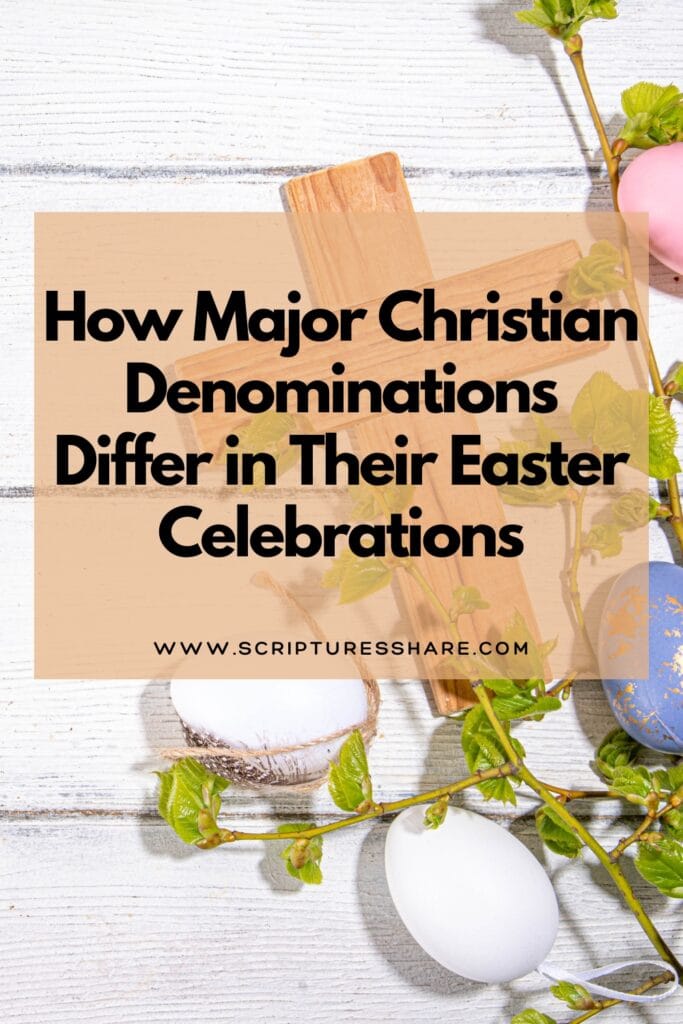No products in the cart.
How Major Christian Denominations Differ in Their Easter Celebrations
ADVERTISEMENT
This post contains paid and/or affiliate links. I make a small commission at no extra cost to you. Please see our Privacy Policy.
Easter is a big deal in Christianity, marking Jesus Christ’s resurrection. Yet, different Christian groups celebrate Easter in their own ways, revealing their unique traditions, beliefs, and cultural backgrounds. Learning about these differences can help us appreciate the rich diversity of the Christian faith worldwide.
Timing of Easter Celebrations
One big difference is when Easter is celebrated. Western churches like Roman Catholics and Protestants follow the Gregorian calendar. On the other hand, many Eastern Orthodox churches stick to the Julian calendar.
This means Easter can fall on different Sundays. Sometimes, it’s even weeks apart. For example:
- Roman Catholic and Protestant churches: Celebrate Easter on the first Sunday after the first full moon after the vernal equinox (Gregorian calendar).
- Eastern Orthodox churches: Celebrate Easter later in most years because their calculation is based on the Julian calendar and must occur after the Jewish Passover.
Liturgical Practices and Services
Easter services vary in style and form. Each denomination has its own rituals that make the Resurrection celebration special for its congregation.
Roman Catholic Easter
The Roman Catholic Church has a structured liturgy during Holy Week. The Easter Vigil on Holy Saturday night is a highlight. It includes the Paschal candle lighting, scripture readings, and the renewal of baptismal vows. The service moves from solemn to joyful, celebrating the victory over death.
Eastern Orthodox Easter
Eastern Orthodox Easter services are full of symbolism and beauty. The midnight Easter Vigil features a procession around the church, symbolizing the journey to Jesus’ tomb. The singing of “Christ is Risen” is a key part of the celebration. The use of incense, icons, and chanting adds to the service’s mystique.
Protestant Easter
Protestant churches vary, but many focus on scripture, hymns, and sermons about resurrection hope. Services are often less formal, focusing on personal faith and community joy. For example, some evangelical churches hold sunrise services outdoors to symbolize the dawn discovery of the empty tomb.

Symbols and Customs
Easter customs also show the unique traditions of each denomination.
Use of the Easter Egg
Easter eggs symbolize new life across many traditions, but each has its own twist:
- Roman Catholic and Protestant: Eggs are decorated or used in hunts as a fun activity.
- Eastern Orthodox: Red eggs represent Christ’s blood and resurrection. The custom of “egg tapping” symbolizes Christ breaking the tomb.
Foods and Celebrations
ADVERTISEMENT
Easter meals also vary:
ADVERTISEMENT
- Roman Catholics and Protestants: Enjoy ham, lamb, and veggies at Easter brunch or dinner.
- Eastern Orthodox: The fast ends after the midnight service. Meals include lamb, bread, and sweet cheese desserts.
Tracing the Roots of Easter Traditions in Christianity
Easter traditions in different Christian groups come from history and culture. They have changed over time.
Today’s Easter celebrations mix early Christian practices, local customs, and each church’s unique views.
At first, Easter was tied to the Jewish Passover. This was because Jesus’ resurrection happened around Passover time.
As Christianity spread, local cultures influenced how Easter was celebrated. For example, in Europe, spring festivals merged with Christian traditions, leading to symbols like eggs and rabbits.
How Eastern Orthodox, Roman Catholic, and Protestant Traditions Diverge
Christian groups celebrate Easter differently because of their beliefs, calendars, and cultures. The main groups are the Eastern Orthodox Church, the Roman Catholic Church, and various Protestant churches.
| Denomination | Easter Date | Main Traditions | Cultural Influences |
|---|---|---|---|
| Eastern Orthodox | Often later than Western Easter due to Julian calendar use | Midnight Resurrection services, procession with candles, feasting | Byzantine rituals, Greek, Slavic folk customs, and emphasis on mysticism |
| Roman Catholic | Gregorian calendar, normally earlier than Orthodox Easter | Vigil masses, Stations of the Cross, Holy Week observances | Roman liturgical traditions, European medieval influences |
| Protestant | Follows Gregorian calendar but varies slightly across denominations | Sunrise services, sermons on resurrection, community meals | Reformation simplicity, local cultural customs, modern adaptations |
How These Differences Enrich Easter
Easter celebrations show the diversity of Christian faith. These differences highlight how the resurrection story is told and celebrated in various ways.
ADVERTISEMENT
Participating in these traditions can deepen faith and build respect among Christians.
From the solemn candles of a Roman Catholic vigil to the joyful singing in a Protestant sunrise service, each tradition offers a unique way to connect with Easter’s message.
These differences celebrate the rich heritage of Christianity, providing many ways to experience Easter’s joy and hope.
Advertisement. Scroll to continue reading.
Historical Events That Molded Easter Practices
Several key historical decisions and occurrences have shaped Easter celebrations:
- Council of Nicaea (325 AD): This council established the method for determining Easter’s date, aiming for unity in Christian practice. It led to Easter being celebrated on the first Sunday after the first full moon following the vernal equinox.
- Gregorian Calendar Reform (1582): Introduced by Pope Gregory XIII, this calendar adjustment modified Easter’s date in Western Christianity, causing divergence from Eastern Orthodox calculations.
- Protestant Reformation (16th Century): The movement’s emphasis on scripture and personal faith led to simplified Easter observances, moving away from some traditional Catholic rituals.
These events highlight that Easter traditions are not static but respond dynamically to changing religious, political, and social contexts.
Regional and Cultural Adaptations of Easter Customs
Christian celebrations have always absorbed regional cultural elements, creating a diverse range of customs:
Use of Easter Eggs and Symbols
Advertisement. Scroll to continue reading.
The egg, a symbol of new life and resurrection, became prominent in many Christian Easter celebrations. In Eastern Europe, elaborately hand-painted pysanky eggs are traditional, reflecting Slavic artistry and symbolism.
Western Europe incorporated chocolate eggs and the Easter bunny—symbols derived from pre-Christian fertility rites.
Music and Liturgical Expression
In Roman Catholic and European Orthodox churches, Easter is marked by special chants and hymns that trace back to ancient church music traditions. Protestant churches often focus on communal singing and contemporary worship styles, reflecting cultural shifts.
Food and Feasting
Feasting is a universal Easter practice but takes culturally-specific forms. Mediterranean Christians often enjoy lamb, symbolizing Christ as the Lamb of God.
Northern European countries may emphasize baked goods or special breads, while some African congregations incorporate local ingredients into celebratory meals.
Theological Differences Shaping Easter’s Focus
While all Christian denominations celebrate the resurrection, the theological lens through which Easter is viewed adds another layer of diversity:
- Eastern Orthodox emphasize the mystical nature of Christ’s victory over death, using elaborate liturgies that evoke awe and spiritual renewal.
- Roman Catholics focus on the passion, death, and resurrection sequence, with rich rituals surrounding each phase during Holy Week.
- Protestants often center Easter on personal salvation and the resurrection’s hope, sometimes minimizing ritual in favor of preaching and reflection.
This theological variety influences the structure and tone of Easter services, shaping what believers experience during this pivot point.
Unity Amidst Diversity in Easter Celebrations
Despite differences in date, rituals, and cultural expressions, the core significance of Easter remains shared—a celebration of hope, renewal, and the resurrection of Jesus Christ.
This unity in faith, expressed through diverse traditions shaped by history and culture, enriches the global Christian experience.
When you observe Easter traditions, whether attending a sunrise service or sharing an Easter meal with family, remember that you are participating in a rich tapestry of faith and culture that has developed over millennia, reflecting the broad and beautiful heritage of Christianity worldwide.
Conclusion
Exploring how major Christian denominations celebrate Easter shows a rich mix of faith. The Roman Catholic Church has solemn liturgies.
Eastern Orthodox Christians have vibrant services. Many Protestant communities have reflective gatherings.
Each tradition has its own way to honor Jesus’ resurrection. These differences show the impact of history and culture.
They reflect centuries of cultural and theological influences.
Understanding these differences helps us appreciate Easter’s significance worldwide. The history of Easter, from early church practices to local customs, shows it’s a living tradition.
It evolves while keeping its core message of hope and renewal.
Seeing the diversity in Easter celebrations lets us connect with the global Christian family. It invites us to look beyond familiar customs. This way, we can connect more deeply with others.
Advertisement. Scroll to continue reading.
Learning about these distinct practices gives us insight into the Christian heritage. It shows how faith has been expressed and adapted over time.
This knowledge makes Easter more meaningful, giving us fresh perspectives on resurrection and shared joy.
Easter’s celebration, in all its forms, inspires believers. It encourages us to reflect on faith, resurrection, and renewal, making Easter a deeply personal yet profoundly communal observance.
ADVERTISEMENT













